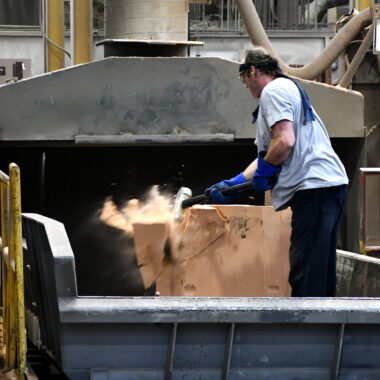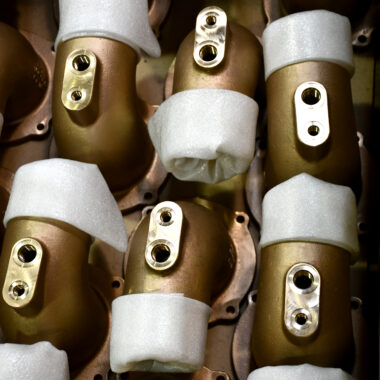Accuracy in Practice: The Art About Aluminum Casting
Accuracy in Practice: The Art About Aluminum Casting
Blog Article
Explore the Globe of Aluminum Spreading: Insider Approaches and keys
In the world of production, light weight aluminum casting stands as a critical procedure, crucial for the development of a vast range of products. Behind the relatively simple technique lie a plethora of elaborate elements, typically unbeknownst to many. As we browse via the world of aluminum spreading, there exists a world of insider tricks and strategies that can elevate the top quality of the end products and streamline the manufacturing procedure. By revealing these hidden gems and exploring the nuances of this craft, a whole new dimension of opportunities arises, guaranteeing to reinvent the means we engage and perceive with light weight aluminum casting.

The Fundamentals of Light Weight Aluminum Casting
Aluminum casting, a fundamental procedure in production, involves the putting of molten aluminum right into a mold to attain wanted forms and frameworks. This versatile method is commonly utilized throughout various industries due to light weight aluminum's exceptional properties such as high strength-to-weight ratio, corrosion resistance, and thermal conductivity.
The process begins with the melting of aluminum in a heating system at temperatures exceeding 1220 ° F(660 ° C ) As soon as the light weight aluminum reaches its liquid state, it is put into a pre-designed mold cavity. The mold and mildew, commonly made from products like steel or sand, identifies the final shape of the cast light weight aluminum component.
After putting, the aluminum is delegated strengthen and cool within the mold - about aluminum casting. This cooling period is critical as it figures out the integrity and high quality of the final item. Once strengthened, the mold and mildew is gotten rid of, disclosing the newly created aluminum spreading
Expert Tips for Effective Casting
To attain optimum outcomes in light weight aluminum spreading, meticulous focus to detail during the mold and mildew layout phase is necessary for making sure successful results. Surveillance and controlling the metal temperature throughout the spreading process can assist avoid concerns such as early solidification or porosity in the last item.
A well-prepared mold surface can add to better steel flow, minimized turbulence, and boosted surface coating on the cast component. By paying close attention to these insider tips, suppliers can enhance the high quality and efficiency of their light weight aluminum casting processes.
Advanced Methods in Light Weight Aluminum Spreading
Using sophisticated approaches and cutting-edge approaches, the world of light weight aluminum casting has actually seen a considerable development towards progressed strategies that push the borders of traditional methods. One such technique is vacuum spreading, which includes creating a vacuum atmosphere to get rid of air from the mold tooth cavity, causing better and more detailed castings with minimized porosity. In addition, financial investment spreading, also understood as lost-wax casting, is a refined technique that enables thin wall surfaces and intricate shapes, leading to accurate and in-depth light weight aluminum components.

Additionally, progressed simulation software program plays a vital role in optimizing spreading styles and forecasting possible issues, enabling changes to be made before the real spreading procedure begins. By welcoming these advanced techniques, suppliers can elevate their light weight aluminum casting capabilities to brand-new elevations, fulfilling the demands of modern industries with precision and innovation.
Comprehending Various Casting Techniques
Different spreading techniques provide special advantages and are picked based on aspects such as the complexity of the layout, manufacturing volume, product demands, and cost factors to consider. One of the most common casting approaches is sand casting, where a mold is developed making use of sand as the key material.
One more popular spreading technique is pass away spreading, which involves infusing liquified steel into a mold cavity under high stress. Pass away casting is recognized for its high accuracy, smooth surface area like it finish, and the capability to create intricate forms with limited resistances. Gravity spreading, on the other hand, depends on gravity to fill up the mold dental caries with liquified steel. This technique appropriates for creating easier shapes and is affordable for small to tool production runs. By recognizing the nuances of various spreading methods, makers can make educated choices to enhance their manufacturing processes and achieve the preferred results.
Optimizing Effectiveness in Casting Operations
With a solid grasp of the nuances of various spreading techniques, makers can simplify their procedures to boost performance in steel manufacture processes. Taking full advantage of performance in casting operations needs a systematic strategy that concentrates on enhancing every step of the casting process.
In addition, purchasing sophisticated technology and tools can dramatically enhance efficiency in casting procedures. Automated systems, robotics, and computer-aided design (CAD) software program can streamline processes, reduce errors, and boost output. Furthermore, training employees on the most up to date techniques and best methods can likewise add to making best use of effectiveness in casting procedures.
Routine upkeep of devices and devices is essential to reduce and stop break downs downtime - about aluminum casting. Applying a positive maintenance schedule can aid determine possible problems prior to they intensify, guaranteeing smooth operations and uninterrupted manufacturing. Overall, by prioritizing performance and continual enhancement, makers can visit optimize their spreading operations and stay competitive in the industry

Conclusion
Finally, the world of light weight aluminum spreading provides a large array of possibilities for those seeking blog to produce elaborate and resilient steel items. By grasping the essentials, making use of expert pointers, and exploring sophisticated strategies, individuals can accomplish excellent success in their casting undertakings. Understanding the different spreading approaches and optimizing performance in operations are essential elements to attaining high-grade cause light weight aluminum casting. With commitment and method, one can truly open the possibility of this functional metalworking process.
One such strategy is vacuum cleaner spreading, which entails producing a vacuum cleaner atmosphere to remove air from the mold and mildew dental caries, leading to greater high quality and even more detailed castings with minimized porosity (about aluminum casting). In addition, investment casting, likewise understood as lost-wax spreading, is a refined method that enables for thin walls and complex shapes, resulting in accurate and in-depth aluminum components
One of the most common spreading methods is sand casting, where a mold and mildew is produced using sand as the key product.One more prominent casting approach is die casting, which involves infusing liquified steel right into a mold tooth cavity under high stress. Understanding the different casting methods and enhancing effectiveness in procedures are vital parts to achieving premium results in light weight aluminum casting.
Report this page